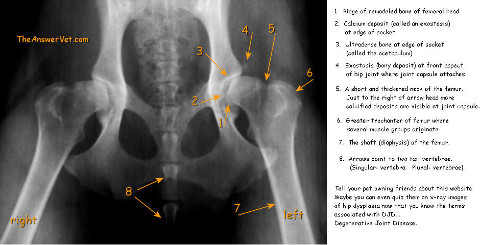Common Questions Regarding Dog Hip Dysplasia
Exactly what is canine hip dysplasia?
Canine hip dysplasia (CHD) is just one of the most aggravating conditions in veterinary medicine today simply since it is so hard to prevent and address. CHD is a developmental disease of the bones in which the head of the upper leg bone poorly matches the hip outlet, triggering damage to the cartilage, gradual destruction of the shared, ache and swelling. This illness must not be puzzled with hip arthritis. Rather, it is the most common cause of arthritis in the hips.

Picture from TheAnswerVet.com
Just how is canine hip dysplasia transferred?
CHD is a heritable disease. It is passed on by the moms and dads to the young. The only effective step as a result to eliminate the illness is to stop pets with hip dysplasia from reproducing. Nonetheless, this is much easier explained compared to done, due to the fact that not all canines with hip dysplasia program signs of the condition. Apparently regular puppies still carry the gene for CHD and are reproduced, triggering the disease to remain within the genepool.
How do you know if your dog has hip dysplasia?
A canine with hip dysplasia usually has less electricity and movement. It has trouble climbing from a resting placement, lameness in the back legs, is hopping like a bunny when running, and hesitates to go up the stairways. Nonetheless, these signs are often not evident till the pet reaches midlife. In severe situations though, some pets show evident hip problems as early as 5-6 months of age.
How does a veterinarian confirm if a pet dog has hip dysplasia?
Unfortunate to claim, there is no blood examination or hereditary examination yet that will identify if a dog is a carrier of CHD or otherwise. Diagnosis of the disease is regularly done through health examinations and x-rays. X-rays help in assessing how bad the disorder is, and via contrast with future x-rays, it can likewise work as a gauge of just how well the picked procedure is working. Two procedures for taking x-rays of CHD-afflicted pets are below:.
1.hip-extended ventrodorsal sight x-ray-- It offers a frontal view of the pelvis and hip-joints and ideal evaluates the degree of intensity of arthritis present.
2. PennHIP radiography procedure-- It is used to detect hip looseness in pet dogs as young as 4 months old.
What are the treatment choices for canine hip dysplasia?
There is no genuine treatment for CHD simply yet, yet there are conservative or non-surgical methods to ease its symptoms. These consist of using drugs to relieve pain and irritation. Rimadyl, Ectogesic and Deramaxx work and have given a lot of experiencing pet dogs the relief had to live a typical life. Weight loss programs, regulated physical exercise and physical treatment are likewise very efficient in particular instances.
When conservative therapy is insufficient, the just various other choice is surgical treatment. Surgical procedure could be really effective as it remedies the underlying cause of hip discomfort which is a malformed joint. Surgical treatment is approached in 2 various methods when taking care of hip dysplasia. Prophylactic surgical treatment is done to stop the progression af arthritis while restorative surgical procedure aspires to address currently arthritic hips.
Three-way pelvic osteotomy is the main precautionary procedure readily available. It involves chopping the hips in 3 locations and spinning the hip sockets to supply much better insurance coverage. This procedure is effective as long as it is done before arthritis arrive or prior to the joint is damaged. An additional kind of precautionary surgery, although still being examined if it works or otherwise, is pubic symphysiodesis. This includes adjusting the method the hips expands to make certain a tighter hip. This treatment is done on really youthful puppies.
Restorative treatments feature total hip substitute and femoral head ostectomy. Overall hip replacement is carried out primarily on larger pets. High thickness, clinical plastic is utilized to change the outlet and a high-quality, non-corrosive alloy is utilized for the ball. This treatment has a high excellence rate, virtually totally does away with pain and enables the pet to entirely resume activity.
An additional therapeutic procedure for hip dysplasia is femoral head ostectomy. It includes the elimination of the leading of the thigh which after that does away with the uncomfortable grinding at the hip joint. The femur is after that enabled to drift easily causing the formation of mark tisue which after that serves as an untrue joint. This treatment is not advised for mild instances of arthritis and is generally effective only on smaller sized, well-muscled canines.
Can canine hip dysplasia be stopped?
The very best action of deterrence is naturally cautious breeding because hip dysplasia is a heritable problem. The beginning of hip dysplasia can be delayed in a lot of pet dogs with a hereditary susceptibility by stopping too much weight gain throughout the early months and by ensuring that the puppy does not position undue stress on the hips.
OFA and PennHip supplies info on type threat. Possible puppy buyers are encouraged to inspect for lineages for OFA, PennHip or GDC certifications. For more information on OFA and PennHip, go to this site: WorkingDogs.com
